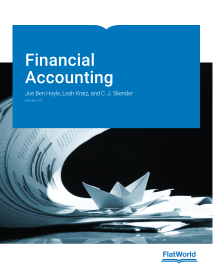Textbook Details

- By:
- Joe Ben Hoyle, Leah Kratz, and C. J. Skender
- Published:
- January 2025
- Discipline:
- Accounting Textbooks
- ISBN (Digital):
- 979-8-88794-233-9
Brief Table of Contents
Chapter 1: What Is Financial Accounting, and Why Is It Important?
Chapter 2: What Should Decision Makers Know in Order to Make Good Decisions About an Organization?
Chapter 3: How Is Financial Information Delivered to Decision Makers Such as Investors and Creditors?
Chapter 4: How Does an Organization Accumulate and Organize the Information Necessary to Create Financial Statements?
Chapter 5: Why Is Financial Information Adjusted Prior to the Production of Financial Statements?
Chapter 6: In Financial Reporting, What Information Is Conveyed About Receivables?
Chapter 7: How Does a Company Gather Information about Its Inventory?
Chapter 8: Why Does a Company Need a Cost Flow Assumption in Reporting Inventory?
Chapter 9: In a Set of Financial Statements, What Information Is Conveyed about Property and Equipment?
Chapter 10: In a Set of Financial Statements, What Information Is Conveyed about Intangible Assets?
Chapter 11: In a Set of Financial Statements, What Information Is Conveyed about Investments?
Chapter 12: In a Set of Financial Statements, What Information Is Conveyed about Current and Contingent Liabilities?
Chapter 13: In a Set of Financial Statements, What Information Is Conveyed about Noncurrent Liabilities Such as Bonds?
Chapter 14: In a Set of Financial Statements, What Information Is Conveyed About Other Noncurrent Liabilities?
Chapter 15: In a Set of Financial Statements, What Information Is Conveyed about Shareholders’ Equity?
Chapter 16: In a Set of Financial Statements, What Information Is Conveyed by the Statement of Cash Flows?
Appendix A: Present Value Tables
Appendix B: Summary of Ratios and Financial Indicators
